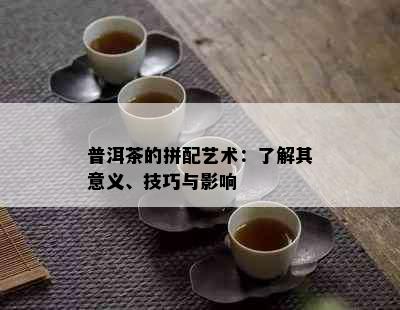
Title: The Art of Blending Pu-erh Tea: Understanding Its Meaning, Techniques, and Impact
Introduction
Pu-erh tea, a unique variety of Chinese tea, has gned immense popularity for its rich flavor, health benefits, and cultural significance. One essential aspect of Pu-erh tea production is blending, which plays a crucial role in determining the quality and taste of the final product. This article ms to explore the concept of blending in Pu-erh tea, its significance, techniques, and the impact it has on the tea's overall character.
1. What Does Blending Mean for Pu-erh Tea?
Blending, as mentioned in the provided corpus, is a term that signifies the process of combining different types of tea leaves or batches from various origins, grades, or aging periods to create a harmonious and balanced flavor profile. This technique allows tea producers to achieve a consistent quality and taste in their products, catering to the diverse preferences of tea enthusiasts worldwide.
2. The Significance of Blending in Pu-erh Tea
2.1. Enhancing Flavor Complexity
Blending different tea leaves can result in a more complex and layered flavor profile, offering a richer experience to the drinker. By combining leaves from different regions, grades, or aging periods, producers can create a unique taste that highlights the best qualities of each component.
2.2. Achieving Consistency
Consistency is crucial in the tea industry, as customers expect a uniform taste and quality in their favorite Pu-erh teas. Blending helps achieve this consistency by balancing the flavors and characteristics of various tea batches, ensuring that the final product meets the desired standards.
2.3. Extending Limited Resources
Blending allows tea producers to make the most of their resources by combining lower-grade leaves with higher-grade ones, creating a more affordable yet enjoyable tea. This practice also helps in utilizing tea leaves that might not be suitable for standalone consumption.
3. Techniques of Blending Pu-erh Tea
3.1. Grade Blending
Grade blending involves combining leaves of different grades, such as young and mature leaves, or leaves from different parts of the plant. This technique helps balance the flavor and aroma of the tea, resulting in a well-rounded and harmonious taste.
3.2. Origin Blending
Origin blending refers to the mixing of leaves from different tea-growing regions. This technique allows producers to combine the unique characteristics of each region, such as the terroir, climate, and soil conditions, to create a distinct flavor profile.
3.3. Age Blending

Age blending is the process of mixing leaves from different aging periods. This technique can help balance the intensity of flavors and create a more complex taste, as younger leaves tend to be more vibrant and fresh, while older leaves offer a deeper, earthier flavor.
4. The Impact of Blending on Pu-erh Tea
4.1. Aroma and Taste
Blending can significantly affect the aroma and taste of Pu-erh tea. A well-blended tea will have a harmonious balance of flavors, with no single element overpowering the others. This balance ensures that the tea is enjoyable and appealing to a wide range of palates.
4.2. Health Benefits
While blending does not inherently alter the health benefits of Pu-erh tea, it can enhance the overall nutritional profile by combining leaves from different origins and grades. This can result in a more potent blend with increased antioxidants, vitamins, and minerals.
4.3. Market Demand
The demand for blended Pu-erh teas has grown significantly in recent years, as consumers seek unique and interesting flavors. Blending allows producers to cater to this demand, creating innovative and diverse tea products that appeal to a broader audience.
Conclusion
The art of blending Pu-erh tea is an essential aspect of its production, offering a myriad of benefits to both producers and consumers. By combining leaves from different origins, grades, and aging periods, tea producers can create a rich, complex, and consistent flavor profile that caters to the diverse preferences of tea enthusiasts. As the demand for blended Pu-erh teas continues to grow, understanding the significance, techniques, and impact of blending will become increasingly important for those involved in the tea industry.
请使用浏览器的分享功能分享